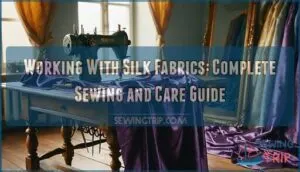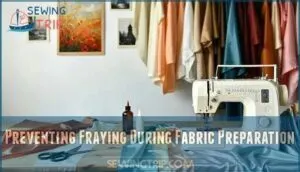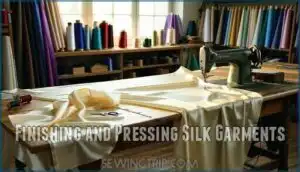This site is supported by our readers. We may earn a commission, at no cost to you, if you purchase through links.

Silk demands respect, not fear, and once you understand its unique structure and behavior, you’ll discover it’s one of the most rewarding fabrics to work with. The key lies in adjusting your technique to match silk’s natural properties: its tendency to shift, its sensitivity to heat, and its exceptional ability to drape in ways synthetic fibers can only imitate.
Master the fundamentals of stabilizing, cutting, and stitching these lustrous fibers, and you’ll transform challenging projects into garments that showcase both your skill and silk’s superior elegance.
Table Of Contents
Key Takeaways
- Silk’s protein structure requires fundamentally different handling than cotton or synthetics—success depends on mastering stabilization techniques, precise cutting with rotary tools, and adjusting machine tension to 1.5-2mm stitches with Microtex needles sized 60/8 or 70/10.
- Single-layer cutting with pattern weights eliminates the shifting and distortion that plague multi-layer approaches, while hand basting and strategic use of tissue paper or spray stabilizers give you complete control over slippery varieties like charmeuse and chiffon.
- Proper pressing demands a protective cloth barrier, low-to-medium heat settings, and working from the wrong side to prevent scorching, water spots, or shine that permanently damage silk’s lustrous surface.
- Long-term preservation hinges on prewashing before construction, hand washing with silk-specific detergent in cool water, air-drying flat in shade, and storing garments in breathable cotton bags away from direct light to prevent yellowing and fiber degradation.
Essential Properties of Silk Fabrics
Before you cut your first piece of silk, it helps to understand what makes this fiber behave the way it does. Silk’s unique properties influence every decision you’ll make, from choosing your pattern to pressing your finished seams.
Let’s look at how silk is created, the different types you’ll encounter, and why designers keep coming back to this extraordinary material.
How Silk is Made and Processed
The journey from silkworm cocoon to luxurious fabric is a transformation that begins with heat, patience, and thousands of years of refined technique.
You’ll witness cocoon boiling as the critical first step in fiber extraction, where carefully controlled heat unravels the protective silk casing. This fiber arts process releases continuous protein filaments that can stretch over half a mile from a single cocoon.
Through yarn spinning and weaving techniques, these delicate natural fibers become the luxury fabrics you’ll use in textile manufacturing, their properties determined by how the material is managed during this transformation.
Key Types of Silk and Their Characteristics
Once silk fiber emerges from processing, your choice of silk fabric type shapes every aspect of your sewing and design work. Different silks behave distinctly at the cutting table and under the needle, each offering unique management characteristics.
- Mulberry Silk – Comprising 90% of global production, this finest silk features 8-11 micron fibers with radiant luster and outstanding dye uptake, making it ideal for silk satin and silk chiffon applications where drape matters most.
- Tussah Silk – Wild-harvested with thicker 70-micron fibers, this variety delivers a matte sheen and natural golden tones, perfect for textured garments requiring environmental resilience.
- Charmeuse Fabric – Weighing 16-22 momme with its signature glossy-front, matte-back construction, charmeuse offers excellent breathability and low friction for evening wear and lingerie projects.
For structured designs, silk dupioni provides crisp dupioni textures with prominent slubs from double cocoons, while types of silk fabric like crepe de chine deliver subtle surface texture through twisted yarns. Understanding the silk production process is key for selecting the right silk fabric for your project.
Benefits of Silk in Clothing and Design
Beyond the technical specs and fabric weights, silk transforms your designs by naturally regulating temperature, resisting allergens, and lending an unmistakable drape that synthetic fibers can’t replicate. That’s why luxury materials like silk fabric remain at the vanguard of textile innovation and fashion trends.
| Benefit | Design Application |
|---|---|
| Thermal regulation | All-season garments with natural comfort |
| Hypoallergenic properties | Sensitive-skin clothing and sleepwear |
| Premium tensile strength | Durable luxury fabric for structured pieces |
The benefits of silk clothing extend beyond aesthetics—you’re working with fabric properties that elevate both fabric durability and silk sustainability in contemporary design.
Choosing and Preparing Silk for Sewing
Your success with silk starts long before the first stitch—it begins with choosing the right fabric and preparing it properly.
The type of silk you select, how you stabilize its slippery surface, and which patterns you pair it with will determine whether your project becomes a masterpiece or a frustration.
Here’s what you need to know to set yourself up for sewing success.
Selecting The Right Type of Silk Fabric
Your project’s success hinges on one pivotal decision: choosing a silk that matches both your design vision and your skill level. Consider how different types of silk fabric behave—crisp taffeta holds structure, while charmeuse drapes like liquid.
Examine weave patterns and texture closely, as slubby dupioni creates visual interest that smooth habotai can’t match.
Fiber blends affect both color selection and fabric properties, so you’ll want to test how your chosen silk manages before committing to your design.
Stabilizing and Handling Slippery Silks
Slippery silks—chiffon, charmeuse, and habotai—can slide off your cutting table faster than you can pin them, but a few stabilizing tricks will bring them under your control. Master these silk management tips:
- Spray fabric adhesives lightly on your cutting surface to anchor slippery fabric without residue
- Layer tissue paper beneath silk during cutting for controlled fabric manipulation
- Apply spray stabilizer to lend temporary body, transforming charmeuse into manageable material
- Use interfacing techniques on necklines and button bands before construction begins
- Weight fabric edges with pattern weights instead of pins to prevent distortion
These silk fabric stabilizers transform sewing techniques for silk from frustrating to precise.
Pattern Selection Tips for Silk Projects
The right pattern unlocks silk’s potential—choose one that celebrates drape and movement rather than fighting the fabric’s liquid nature. Look for designs with bias cuts, minimal darts, and fluid silhouettes that allow silk fabric to flow naturally. Avoid patterns requiring excessive easing or complex seam placement.
| Pattern Feature | Best for Silk |
|---|---|
| Seam complexity | Simple, straight seams |
| Dart placement | Minimal or soft tucks |
| Ease requirements | Loose or relaxed fit |
| Construction details | Bias cuts, flowing lines |
Cutting and Marking Silk With Precision
Cutting silk demands precision from the first snip to the final marked line. The right tools and techniques will keep your fabric from shifting, fraying, or distorting as you prepare it for sewing.
Here’s how to manage each step with confidence and control.
Using The Best Tools for Cutting Silk
Choosing your cutting tools is like selecting the right brush for a masterpiece—precision here transforms your silk project from frustrating to impeccable. For clean, continuous cuts on delicate weaves, professional sewists swear by three essentials:
- Rotary cutters with sharp 28mm to 45mm blades, paired with a self-healing cutting mat, slice through slippery silk with up to 40% faster speed and minimal distortion
- Serrated shears featuring microserration scissors or high-carbon steel blades that grip gossamer fabrics, reducing slippage by over 50% compared to straight edges
- Laser machines for industrial applications, achieving tolerances within 0.3mm for complex pattern work
Keep blade sharpening schedules strict—professionals resharpen every 40 to 50 hours—and always use sharp needles like Microtex needle sizes when shifting to stitching. To achieve ideal results, consider using the paper sandwich method for cutting silk fabrics.
Single-Layer Cutting Techniques
When silk slips and slides like water under your blade, single-layer cutting becomes the control move that separates amateur projects from gallery-worthy work. Spread your silk flat, secure it with pattern weights, and let your rotary cutter glide through one layer at a time—you’ll eliminate distortion and achieve precision marking that honors every thread.
| Technique | Tools Required | Best For |
|---|---|---|
| Weight & Cut | Rotary cutter, pattern weights, cutting mat | Charmeuse, habotai, lightweight silks |
| Stabilized Cut | Fabric stabilizers, sharp scissors, Microtex needle prep | Slippery chiffon, georgette |
| Taped Edge | Low-tack tape, rotary techniques, self-healing mat | Dupioni, organza with body |
| Pinned Single | Fine silk pins, serrated shears, cutting tools | All silk fabric preparation projects |
Marking Seam Allowances Without Damage
One misplaced mark on silk can haunt your finished garment like a ghost under spotlight, so mastering invisible seam allowances is where your craftsmanship truly shows. Protect your silk fabric with these precision tools and damage prevention techniques:
- Tailor’s chalk or disappearing fabric markers – Test on scraps first to confirm complete removal without residue
- Thread tracing with silk pins – Baste seam allowances using fine thread for invisible, removable guides
- Wax-free tracing paper – Apply gentle pressure with a rotary cutter grip when transferring pattern marks
- Clips instead of pinning techniques – Position fabric marking tools along edges to avoid puncture damage
Preventing Fraying During Fabric Preparation
Frayed edges don’t just look messy—they steal precious inches from your seam allowances and unravel your hard work before you even thread the needle.
Shield your cut edges with fabric stabilizers or fray-resistant coatings applied immediately after cutting. Edge sealing techniques like serging or pinking shears offer quick fray prevention, while a light application of diluted fabric glue transforms fragile silk edges into stable, workable surfaces during fabric preparation.
Sewing Techniques for Silk Fabrics
Sewing silk demands a different approach than working with everyday fabrics, where the right techniques can mean the difference between a professional finish and a frustrating project.
Your needle choice, stitch settings, and seam management all play key roles in taming this luxurious but temperamental material.
Here’s what you need to master before your machine touches that first length of silk.
Selecting The Ideal Needle and Thread
Your needle selection sets the foundation for impeccable silk seams, so start with a size 60/8 or 70/10 Microtex needle paired with fine polyester or 100wt silk thread.
Microtex needles feature sharp, acute points that pierce delicate fibers without snagging, while thread compatibility ensures minimal seam bulk and fabric tension remains balanced throughout your sewing techniques.
Adjusting Stitch Length and Tension
Fine-tune your stitch settings to match your silk’s weight—shorter stitches between 1.5 and 2mm anchor lightweight varieties without puckering, while slightly reduced tension prevents the fabric from pulling or distorting along seam lines.
Test your tension adjustment on fabric scraps first, monitoring how thread selection interacts with your machine sewing setup to achieve fabric stability and sewing precision that honors silk’s delicate weave structure.
Hand Basting and Pinning Silk Seams
Before your machine takes over, secure your silk layers with temporary stitches by hand—this old-school approach gives you the control you need when pins alone won’t keep those slippery seams exactly where you want them.
Choose lightweight silk pins that won’t leave marks, spacing them perpendicular to seam allowances for silk fabric stabilization. Hand basting with silk thread gives you precision over pinning techniques, letting you master seam allowance management before committing to permanent stitches.
Preventing Fabric Shifting and Plate Sucking
Even with perfect basting and pinning, lightweight silk has a habit of puckering or getting pulled into your machine’s throat plate—but a few simple adjustments to your feed and starting technique will keep those seams smooth and flat.
Here’s how you’ll master fabric stability and stop plate sucking:
- Start on scrap fabric to anchor your silk before it hits the feed dogs
- Use a straight stitch throat plate to eliminate the wide zigzag opening that swallows delicate fabric
- Adjust tension control slightly lower to prevent puckering without creating loose stitches
- Hold thread tails taut behind your presser foot for the first few stitches
- Layer tissue paper beneath slippery silk as a temporary fabric stabilizer
These techniques transform fabric shifting from frustration into precision, giving you the commanding control your silk projects deserve.
Crafting Silk Buttonholes and Embellishments
Buttonholes on silk aren’t just functional closures—they’re tiny architectural feats that demand the right stabilizer, tension, and finishing touch to prevent fraying or puckering in your most luxurious fabric. You’ll want interfacing behind every buttonhole, hand sewing with silk thread for heirloom finishes, and careful buttonhole stitches that lock edges tight.
Silk embroidery, fabric beading, and silk appliques transform basic garments into showpieces, while decorative trims add structure where delicate weaving needs reinforcement.
Finishing and Pressing Silk Garments
The final touches can make or break your silk project, transforming raw seams and wrinkled fabric into a polished, professional garment.
Proper finishing techniques preserve silk’s delicate fibers while enhancing its natural drape and luster.
Below, you’ll find proven methods for seam finishing, hemming, and pressing that protect your work without compromising the fabric’s integrity.
Seam Finishing Options for Silk
When you’re constructing a silk garment, the seam finishing you choose isn’t just about preventing frays—it’s about honoring the fabric’s elegance while ensuring your work holds up through wear and washing.
French seams remain the benchmark for sheer silks, enclosing raw edges completely for a clean, professional finish.
For opaque silks, consider silk seam binding or a fine overlock stitch that secures without bulk, preserving the fabric’s graceful drape and movement.
Creating Baby Hems and Hand-Rolled Hems
The delicate edge of a silk garment deserves a hem that whispers rather than shouts—enter the baby hem and its cousin, the hand-rolled hem, both designed to finish your fabric with nearly invisible grace.
A baby hem uses a narrow folded edge twice, creating a clean finish that’s perfect for lightweight silks. Hand rolling takes this further, encasing the hem allowance with tiny stitches that secure without bulk.
Both hemming techniques demand patience when sewing silk fabric, but they reward you with hem finishing that honors the material’s fluid beauty.
Proper Use of a Pressing Cloth
Between your iron and silk’s sensitive surface, a pressing cloth acts as your insurance policy—one careless moment of direct heat can turn gleaming fabric into scorched regret. Choose cotton or linen for your cloth selection—both withstand heat management demands while protecting delicate fibers during steam pressing. Position the pressing cloth directly over your silk fabric, never letting the iron touch bare material, and you’ll master ironing silk fabric with pressing techniques that preserve rather than punish.
Pressing wisely means:
- White or light-colored cloth reveals any residue before it transfers to your masterpiece
- Dampening your pressing cloth increases fabric protection during heat application
- Testing temperature on scraps first prevents ironing safety disasters you can’t undo
Tips for Pressing Silk Without Damage
Master the art of pressing silk by treating temperature like a dial you control, not a gamble you take—precision here separates impeccable finishes from permanent damage. Set your iron settings between low and medium heat, testing steam pressing on fabric scraps before committing to your garment.
Press from the wrong side whenever possible, moving the iron steadily rather than dragging it across delicate fibers—this pressing silk wisely approach prevents water spots and shine.
Always allow your pressed silk fabric care masterpiece to cool completely before managing, giving fibers time to set without stretching.
Caring for and Storing Silk Creations
Once your silk garment is complete, the real work begins—keeping it looking as immaculate as the day you finished the last stitch.
Silk’s protein fibers demand specific care routines that differ dramatically from cotton or synthetics, and improper management can dull its luster or weaken its structure.
Let’s walk through the essential practices that’ll preserve your silk creations for years to come.
Best Practices for Washing and Drying Silk
Silk fabric care starts with understanding that most silks shrink and respond differently to water, so prewashing silk is essential before you cut your garment.
Hand washing tips include soaking your silk in lukewarm water with gentle washing, using specialized silk detergent and a splash of distilled white vinegar to preserve the fiber. If you’re using a washing machine, select the hand wash function or delicate cycle, and place your silk in a protective laundry bag. Gentle washing means minimal agitation—lightly move the fabric through the water, then let it rest.
For drying techniques, gently squeeze out excess water without wringing, and lay your silk flat in the shade to air-dry, which prevents fading and maintains the fabric’s integrity.
Ironing and Maintaining Silk’s Luster
Once your silk is clean and dry, you’ll want to coax back its signature sheen with careful ironing—but this step can make or break the fabric’s luxurious finish. Pressing silk wisely means protecting its delicate fibers while restoring drape and wrinkle removal.
Here’s how to master silk ironing tips for luster preservation:
- Set your iron to the lowest heat setting before touching silk fabric
- Always press on the reverse side or use a clean pressing cloth for fabric care
- Iron while the fabric is slightly damp for easier wrinkle removal and silk finishing
- Consider fabric steaming as a gentler alternative that maintains silk’s natural sheen
Storing Silk Garments for Longevity
After your silk is pressed and gleaming, proper storage becomes the deciding factor in whether that luster lasts for years or fades within months. You’ll need breathable storage—cotton garment bags work beautifully—to shield silk from light while preventing moisture buildup.
Choose cool, dark closet organization spaces, and fold your fabric gently along natural seam lines rather than sharp creases that compromise silk preservation and garment construction integrity over time.
Handling Silk Accessories and Special Items
Scarves, ties, and pocket squares demand their own management protocol—you can’t just toss these smaller, high-value pieces in with your garments and expect them to emerge unscathed. These accessories require dedicated silk scarf care and tie maintenance strategies that preserve their integrity through countless wears.
- Roll scarves loosely around acid-free tissue to prevent creasing while maintaining silk fabric structure
- Store ties flat or on specialized hangers to avoid tension on delicate weaving techniques for silk
- Use silk pins sparingly during silk bag making projects to prevent permanent puncture marks
- Apply embellishment techniques with hand sewing techniques rather than aggressive machine stitching for accessory storage longevity
Frequently Asked Questions (FAQs)
Can silk be dyed at home safely?
Yes, you can dye silk at home safely using natural dye methods or acid dyes designed for protein fibers.
Proper fabric preparation tips include prewashing silk through gentle hand washing, which removes residues and ensures even dye absorption.
Follow dye fixing techniques and home dye safety protocols carefully.
How do you repair snags in silk?
Gently tease snags back through the fabric using a fine needle, working from the reverse side.
Pull loops to the wrong side, then secure with tiny hand stitches using matching silk thread.
What causes silk to yellow over time?
Exposure to ultraviolet light, perspiration, and environmental pollutants accelerates Fiber Oxidation and the Aging Process, causing yellowing in silk fabric. Poor storage conditions and contact with acidic substances intensify these Yellowing Effects, compromising the fabric’s natural luster through gradual Silk Degradation.
Is silk suitable for quilting projects?
While possible, quilting with silk fabric demands expert sewing techniques and careful fabric selection. Silk’s slippery nature challenges traditional quilt patterns, though silk batting adds luxurious drape. You’ll need specialized silk thread and precise manipulation to prevent shifting during assembly.
How do you remove stains from silk?
Like a delicate crime scene, silk stain removal demands swift, gentle action—blot immediately with cool water, apply specialized silk detergent sparingly, and test any spot treatment on hidden fabric first to verify color preservation during care and maintenance of silk.
Treat silk stain removal like a delicate crime scene—blot swiftly with cool water, test treatments on hidden fabric first, and preserve the fiber’s integrity with gentle care
Conclusion
Consider the first silk blouse you attempted: perhaps the fabric slipped beneath your presser foot, the seams puckered despite careful stitching, or the iron left a permanent watermark across the bodice. These frustrations stem from treating silk like any other fabric rather than honoring its unique protein structure.
Once you’ve mastered the techniques for working with silk fabrics—from stabilizing slippery weaves to pressing with precision—you’ll find that silk responds with extraordinary cooperation, transforming your efforts into garments that drape with distinctive elegance and withstand years of careful wear.
- https://www.grandviewresearch.com/industry-analysis/silk-textiles-market-report
- https://www.indexbox.io/blog/silk-fabric-world-market-overview-2024-3/
- https://www.fortunebusinessinsights.com/silk-market-111687
- https://www.kenresearch.com/industry-reports/usa-silk-market
- https://textileengineering.net/types-properties-and-uses-of-silk-fibre/














